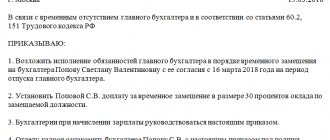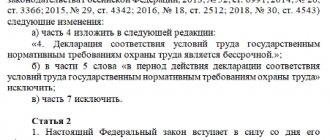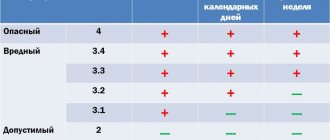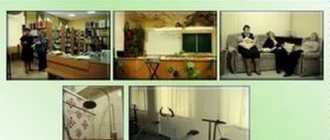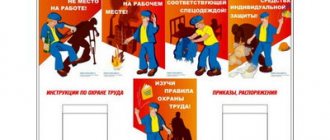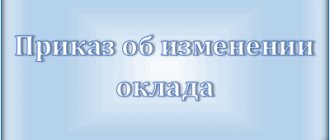The area of labor protection and production safety is a responsibility for management, since penalties, both administrative and other, can “hit” any company very hard.
To fulfill the goals of implementing activities in this area, the manager appoints responsible persons for the implementation of relevant activities.
Individuals are called engineers or OT specialists; medium and large enterprises may have separate OT departments.
There are also frequent cases when an employee, in addition to his main activity, is also assigned responsibilities for carrying out activities in this area and complying with the relevant standards specified by law.
Most often this happens in small businesses with a limited staff.
The normative reinforcement of the assignment of responsibilities is the issuance of an order as an internal local regulatory act of the organization.
Why is it issued?
The execution of an order for the appointment and assignment of functions should serve several purposes:
- Legal assignment of responsibilities for the implementation of labor protection standards to a certain specialist. When conducting an inspection by the state labor inspectorate, first of all, regulations regarding the competence of an occupational safety specialist are checked, including the order for his appointment, as well as the grounds for this appointment.
- Empowering a specialist with rights and responsibilities in the implementation of a set of labor protection measures. Without documentary confirmation of his status, an occupational safety specialist does not have the appropriate administrative powers in relation to the organization’s employees and does not have the right to legally involve them in safety activities.
- If a combination occurs, the employee’s payment procedure also changes. This fact should also be reflected in the relevant order. If an employee, in addition to performing his main production functions, is engaged in activities to comply with labor safety standards within his working hours, an appropriate additional payment must be made.
We also offer orders for:
- distribution of occupational safety responsibilities among officials.
Order and Regulations on the Distribution of Functions to Ensure Safe Conditions and Labor Protection!
Greetings, dear friends! In this note, I suggest you download for free the Order on the distribution of functions for ensuring safe conditions and labor protection between managers and specialists, and with it the Regulations on the assignment of functions to ensure safe conditions and labor protection between managers and specialists.
The provision on the assignment of functions to ensure safe conditions and labor protection between managers and specialists has been implemented for a full-fledged enterprise. For understanding, I will give the incomplete content of this provision (full text in MS Word format):
Regulations on the assignment of functions to ensure safe conditions and labor protection between managers and specialists
1. General Provisions
1.1. This Regulation on the assignment of functions to ensure safe conditions and labor protection between managers, specialists and employees of the company (hereinafter referred to as the Regulation) was developed in accordance with the Labor Code of the Russian Federation and other regulatory legal acts on labor protection. 1.2. The regulations establish the main responsibilities of officials (managers and specialists) of the company to ensure healthy and safe working conditions, compliance with the requirements of legislative and regulatory legal acts on labor protection. 1.3. General management of labor protection work in the structural divisions and services of the company is carried out by the General Director. ...
Want to know what safety legislation changes have occurred in 2021? Come to our online conference! Participation is free.
2. Distribution of functions for ensuring labor protection between managers and specialists
2.1. The General Director is obliged to: 2.1.1. Provide general management of the work to create safe working conditions in the company. 2.1.2. Establish the duties, rights and responsibilities in the field of labor protection, safety and fire safety of their deputies, heads of departments and services and ensure the inclusion of these duties and rights in the regulations on departments (services) and in the job descriptions of employees. 2.1.3. Ensure compliance with labor and labor protection legislation, compliance with labor protection and fire safety standards, regulations of state supervision and control bodies, state examination of working conditions. 2.1.4. Ensure the safe operation of industrial buildings, structures, mechanisms, equipment, premises, the safety of technological and production processes used in the production of raw materials. 2.1.5. Organize the development and ensure the allocation of financial resources for the implementation of measures to ensure healthy and safe working conditions. … 2.2. The Deputy General Director (Chief Engineer) is obliged to ensure: 2.2.1. Management of work to ensure labor safety by heads of structural divisions and services. 2.2.2. Organizing the implementation of regulatory legal acts on labor protection in the structural divisions and services of the company and monitoring their implementation. 2.2.3. Implementation of measures to introduce safe equipment and technology. 2.2.4. Compliance with the instructions of state supervisory and control bodies within the established time limits. 2.2.5. Technical supervision over the good condition and safe operation of buildings, premises, social facilities, individual structures, devices, machines, mechanisms, machine tools and other equipment in accordance with the requirements of current labor protection rules and regulations, state labor safety standards. ... 2.3. The Deputy General Director for Capital Construction is obliged to ensure: 2.3.1. Compliance with building codes and regulations, rules and regulations of labor protection, industrial sanitation during capital construction and reconstruction of production facilities, participation in their acceptance into operation; 2.3.2. Organization of safe operation of equipment, machines and mechanisms in subordinate work areas. 2.3.3. Compliance with design discipline in the organization, construction and reconstruction are carried out only according to projects of specialized organizations and in agreement with the author of the project. 2.3.4. Carrying out work to prepare the organization’s structural units for work in the autumn-winter period. 2.3.5. Availability of the required number of sanitary facilities. 2.4. The commercial director is obliged to ensure: 2.4.1. Management of the financial and economic activities of the company in the field of logistics, sales of products on the market and under supply contracts. 2.4.2. Development of labor safety plans within the limits of functional responsibilities. 2.4.3. Compliance with safety requirements during loading and unloading operations, warehousing, storage and transportation of food and non-food products. 2.4.4. Timely preparation of requests for personal and collective protective equipment for workers, as well as their correct acceptance, storage and issuance. 2.4.5. Workers are provided with therapeutic and preventive nutrition, milk, protective creams and pastes in accordance with established standards. ... 2.5. The financial director is obliged to ensure: 2.5.1. Management of the financial and economic activities of the company in the field of planning and management of its production and economic policy, including issues of labor organization and wages. 2.5.2. Organization and implementation of the development of plans and programs for the development of the company, taking into account labor protection requirements. 2.5.3. Planning and financing of financial costs of occupational safety measures. 2.5.4. Control over the use of allocated funds for labor protection measures, including payment for therapeutic and preventive nutrition, purchase of personal protective equipment, etc. 2.5.5. Organization of work to introduce, improve and enhance the role of economic management methods, including labor protection. ... 2.6. The chief accountant (deputy chief accountant) is obliged to: 2.6.1. When planning the financial activities of the company, provide for the costs of implementing labor protection measures; control the correctness of attributing these costs to the appropriate item (“Occupational Safety and Health”). 2.6.2. Conduct payments for labor protection measures in a timely manner. 2.6.3. Organize accounting of the expenditure of funds for the implementation of labor protection measures in accordance with the nomenclature of costs and compensation for damage as a result of accidents, diseases and accidents at work, as well as in connection with the payment of fines by decision of state supervisory and control authorities. ... 2.7. The chief mechanic is obliged to: 2.7.1. Ensure the introduction of safe equipment, good condition, design and operation of technological equipment, facilities controlled by Rostechnadzor, buildings and structures under its jurisdiction in accordance with the requirements of labor protection rules and regulations, industrial sanitation, and labor safety standards. 2.7.2. Ensure timely inspection, testing, preventive inspections and repairs of fixed assets, including facilities controlled by Rostechnadzor. 2.7.3. Ensure that operating instructions for the supplied equipment are taken into account, as well as the development of instructions for the care, supervision, operation and repair of equipment developed and manufactured in the organization and under the supervision of the chief mechanic service. 2.7.4. Ensure the safety of work performed by the chief mechanic service. 2.7.5. Monitor compliance by employees of the chief mechanic service with the requirements of norms, rules, and labor protection instructions. ... 2.8. The chief power engineer is obliged to: 2.8.1. Ensure the maintenance of electrical and electrical technological equipment and networks in working order and its operation in accordance with the requirements of current rules and regulations. 2.8.2. Ensure that operating instructions for the supplied equipment are taken into account, as well as the development of instructions for the care, supervision, operation and repair of equipment developed and manufactured in the organization and under the supervision of the chief power engineer service. 2.8.3. Ensure timely and high-quality implementation of preventive maintenance, repair, modernization and reconstruction of power equipment. 2.8.4. Ensure the reliable operation of electrical installations and the safety of their maintenance. 2.8.5. Ensure that the use of technologies and work practices that have a negative impact on the environment is prevented. ... 2.9. The chief technologist is obliged to: 2.9.1. Ensure compliance of technological processes, devices, equipment and tools with the requirements of labor protection rules and regulations, industrial sanitation, and state labor safety standards. 2.9.2. Ensure that specific safety requirements are reflected in technological documentation and design documentation for special (non-standard) technological equipment. 2.9.3. Organize a comprehensive study of the harmful properties of substances and materials planned for use in production, as well as the development of safety measures for their use. 2.9.4. Coordinate with state sanitary and fire inspection authorities the use of new materials and substances in technological processes. 2.9.5. Carry out work to introduce technological processes that exclude the use of harmful, fire, and explosive materials and substances. ... 2.10. The chief designer is obliged to: 2.10.1. Ensure that the design of machines, mechanisms, and devices being developed or modernized meets the requirements of labor protection rules and regulations, industrial sanitation, and state labor safety standards. 2.10.2. Ensure that specific safety measures are reflected in the testing and operating instructions for new products and systems. ... 2.11. The head of the company's transport department is obliged to: 2.11.1. Ensure the good condition and safe operation of company vehicles. 2.11.2. Ensure compliance with the work and rest regime of car drivers in accordance with current legislation. 2.11.3. Organize the safe transportation of people on company transport and ensure the safe transportation of dangerous goods. 2.11.4. Ensure the organization of safe vehicle repair work. 2.11.5. Monitor compliance by drivers with the rules of technical operation of rolling stock of road transport and road traffic. … 2.12. The head of the production and technical department (PTO) is obliged to: 2.12.1. Ensure, if there are jobs directly subordinate to the technological process, repair, adjustment of equipment and communications, the creation of safe and healthy working conditions, the implementation of measures to improve conditions, labor protection and sanitary and health measures. 2.12.2. Ensure the introduction of scientific organization of labor, improvement of repair technology, mechanization and automation of production processes aimed at facilitating and improving working conditions in workshops and services. 2.12.3. Participate in the development of long-term production development plans, measures aimed at improving conditions and increasing labor safety, improving the organization and technology of production, introducing advanced methods, more advanced automation schemes and other technological means, and monitoring their implementation. ... 2.13. The head of the economic department is obliged to: 2.13.1. Ensure, in the presence of direct subordinate jobs related to the technological process, repair, adjustment of equipment and communications, the creation of safe and healthy working conditions, the implementation of measures to improve conditions, labor protection and sanitary measures. 2.13.2. Ensure the appropriate sanitary condition of the company’s territory, sanitary premises and common areas, medical and preventive services for employees. 2.13.3. Ensure timely disinfection, disinfestation of company premises, washing (dry cleaning) and repair of special clothing, special shoes and other personal protective equipment. 2.13.4. Organize the collection, storage and removal of production waste from the company’s territory. 2.13.5. Organize the work of landscaping and landscaping the company's territory, maintaining sidewalks, pedestrian paths and crossings in good condition, cleaning the territory and timely clearing roads, sidewalks of snow and ice, as well as sprinkling them with sand. ... 2.14. The head of the HR department (HR manager) is obliged to ensure: 2.14.1. General management of work on training and education of personnel, compliance with internal labor regulations, labor discipline, and labor legislation. 2.14.2. Selection and placement of personnel in accordance with qualification requirements and medical indications, taking into account the specifics of regulating the labor of women and adolescents. 2.14.3. Development and timely revision of internal labor regulations, vocational training programs for workers in accordance with current regulations. 2.14.4. Compliance with access regulations, registration and issuance of passes for employees of the company and other organizations. 2.14.5. Organizing control over compliance with the established operating hours of structural units and services. … 2.15. The warehouse manager is obliged to ensure: 2.15.1. Safe maintenance and safe operation of the warehouse in accordance with labor protection requirements, including the appropriate sanitary condition of the warehouse territory and sanitary premises. 2.15.2. Development of occupational safety action plans for the relevant sections. ... 2.16. The head of the legal department (legal consultant) is obliged to ensure: 2.16.1. Legal assistance on labor protection issues to heads of departments and services, trade union organizations and company employees. 2.16.2. Legal opinion on the presented materials on bringing employees to disciplinary and financial liability for violation of labor protection rules. 2.16.3. Coordination of regulatory legal acts (documents) on labor protection developed for use in the company. 2.16.4. Work on legal propaganda, to familiarize company officials with regulations (documents) on labor protection related to their activities, and about changes in current legislation. ... 2.17. The occupational safety specialist is obliged to: 2.17.1. Carry out: — organizational and methodological management and coordination of the work of structural units and services within the framework of the Occupational Safety and Health Management System; — continuous improvement of forms and methods of preventive work on labor protection; interaction with state authorities of supervision and control, the labor protection service of a higher management body, medical organizations on labor protection issues; managing the work of the labor protection office, organizing propaganda and information on labor protection issues; — control over the performance by officials of functional duties on labor protection. 2.17.2. Identify dangerous and harmful production factors in the workplace. 2.17.3. Carry out: - analysis of the state and causes of industrial injuries, occupational and work-related diseases; - together with representatives of the relevant departments (services) and with the participation of authorized (trusted) persons for labor protection of trade unions or the workforce of inspections, surveys or participation in inspections, surveys of the technical condition of buildings, structures, equipment, machines and mechanisms for compliance with their regulatory legal acts on labor protection, the efficiency of ventilation systems, the condition of sanitary and technical devices, sanitary and household premises, collective and individual protective equipment for workers. ... 2.18. Heads of production, departments, workshops, independent production sites are obliged to: 2.18.1. Ensure healthy and safe working conditions in all workplaces. 2.18.2. Ensure the maintenance and operation of equipment, tools, inventory and devices, lifting devices and vehicles, safety and protective devices, sanitary and technical installations, organization of workplaces, production and service premises, passages, driveways in accordance with the requirements of labor protection rules and standards, industrial sanitation. 2.18.3. To ensure the introduction of the latest achievements of science and technology in the field of improving technological equipment, mechanisms, devices in order to increase work safety, reduce occupational diseases, prevent environmental pollution and improve working conditions. 2.18.3. Ensure that subordinate engineering and technical personnel fulfill their labor protection duties. 2.18.4. Monitor employees’ compliance with the requirements of rules, regulations, labor protection instructions, and the organization of high-risk work. 2.18.5. Ensure proper operation of ventilation and air conditioning units. ... 2.19. Craftsmen and work performers are obliged to: 2.19.1. Ensure the organization of work and workplaces in accordance with the requirements of rules, labor protection standards and industrial sanitation. 2.19.2. Ensure compliance with the rules, labor protection and industrial sanitation standards, instructions on labor protection of workplaces, passages and passages, serviceability of equipment, fixtures and tools, availability and serviceability of fencing, screening and locking devices on equipment and installations. 2.19.3. Organize high-risk work in accordance with the work permit (permit) for its implementation. 2.19.4. Directly manage high-risk work, as well as work to prevent or eliminate accidents. 2.19.5. Monitor the availability, proper condition and correct use of personal protective equipment. ... 2.20. The foreman (senior working level) is obliged to: 2.20.1. Ensure that team members comply with labor and production discipline, as well as their use of safe labor practices in accordance with labor protection instructions. 2.20.2. Obtain work permits and other special permits for work that require their execution, and do not allow these works to be carried out without documentation. 2.20.3. Monitor the safe performance of work by team members during a shift (watch). 2.20.4. Organize the provision of first aid to the victim and refer him to a medical facility, inform the foreman (superior manager) about the accident. 2.20.5. Ensure that the situation at the scene of the accident or accident is preserved, unless this threatens their further development. In the event of a possible emergency situation, take the necessary preventive measures to ensure safety. ...
3. Final provisions
3.1. In the case of rental of production premises, maintenance, adjustment and repair of technological and installation equipment by the services of the lessor or another organization, the mutual requirements of the lessee or lessor (or other organization) to ensure healthy and safe working conditions for employees of both organizations must be included in contracts for rental or maintenance of equipment. ...
DOWNLOAD DOCUMENTS: - Order on the distribution of functions to ensure safe conditions and labor protection between managers and specialists - Regulations on the assignment of functions to ensure safe conditions and labor protection between managers and specialists That's all I have for you. Until new notes!
How to assign functions to an employee?
The execution of the assignment order must be carried out in accordance with federal GOST standards and document management rules.
Also, the employee drawing up the order must take into account the rules for maintaining internal document flow.
Before signing, the document must be agreed upon with the personnel and legal services of the organization for compliance with the law.
Also, before signing it, the employee who will subsequently be assigned labor protection responsibilities must be familiarized with it.
The order must necessarily indicate:
- Company name;
- the basis for appointing an employee and assigning the necessary functions to him (the main basis is the presence of special education received at a training center and a certificate of the appropriate type);
- personal data indicating the position of the person charged with labor protection responsibilities;
- conditions of additional payment for combining professions;
- the period for which the duties are assigned (indefinite or during the absence of the main employee).
An example of an order to assign responsibility to:
- employee - sample;
- OT engineer is an example.
An example of drawing up an order on labor protection
- First, in the middle of the line, write the full name of the organization, then below the word “Order” and its number according to the company’s internal document flow.
- Next, indicate the locality in which the company is registered and the date the order was drawn up.
- The next part is the main one: first of all, the basis for the order is indicated here. In this case, this is the implementation of the Labor Code of the Russian Federation in terms of organizing labor protection and safety at work (if desired, you can provide an exact link to the number of the article of the law).
- Next comes the order itself, which states:
- persons responsible for labor protection (positions, last names, first names, patronymics),
- their functional responsibilities (in detail),
- the amount of the salary bonus (in numbers and in words),
- deputies.
- At the end, the document is signed by the manager.
EMPLOYMENT CONTRACTS, PERSONAL CARDS, LABOR COOKS
Employees' employment contracts, their personal cards and work books are the desktop documents of the personnel officer. We did not talk about them in the “Mandatory HR Documents” section, because these are not local regulations, but documents that apply to each employee personally. All of them are required:
• employment contract – in accordance with Art. 56 Labor Code of the Russian Federation;
• work book – in accordance with the Rules for maintaining work books;
• personal card of the employee - the need to maintain it is indicated by clause 12 of the Rules for maintaining work books.
A personal card (unified form No. T-2) is created simultaneously with the employee’s entry into the organization. It contains the employee’s personal data, all information about his movements in the organization, vacations, awards, etc.
An employment contract, personal card and work book are valid documents during the entire period of the employee’s work in the organization. If an employee has been working in an organization for 20 years, his employment contract, work book and personal card are transferable for 20 years. They are closed by office work only after the dismissal of the employee.
While these three documents are valid, they are kept by the personnel officer and stored as documents containing personal data should be stored (more on this below).
Employment contracts and personal cards closed by office work are sent for storage to the personnel archive. Work records are returned to employees upon dismissal. Of course, there are exceptions when, for various reasons, an employee who quit did not pick up his work book - this happens from time to time. It should be remembered that the work book is a document that must be returned, and the employee (or his relatives) can theoretically request it throughout the entire period of storage of this document, and the period is 50 years (Clause 2 of Article 22.1 of Federal Law No. 125-FZ) . Therefore, forgotten work books are under no circumstances stitched together.
Nuances of case formation . Employment contracts and personal cards in the archive form files that are called “Employment contracts of dismissed workers” and “Personal cards of dismissed workers.” These files are formed into volumes in the same way: first by year of dismissal, and then alphabetically by the names of former employees.
